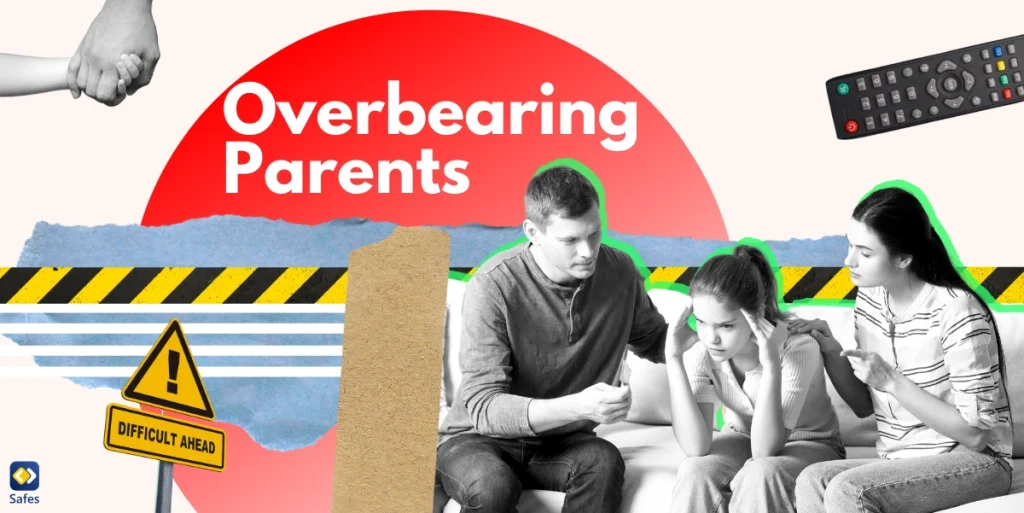The internet offers both opportunities and pitfalls. While it’s packed with educational resources and entertainment, it also exposes users to distractions, harmful content, and security risks. According to Internet Matters, research by the NSPCC revealed that 56% of young people aged 11 to 16 have encountered explicit content online. A Christian web filter app can help users create safer, value-driven online spaces aligned with their ethical or spiritual principles, offering protection without compromising access to useful tools.
Download and Start Your Free Trial of the Safes Parental Control App
Unfiltered browsing leaves families vulnerable to inappropriate material, scams, and viruses. Christian web filters address these concerns by tailoring content restrictions to reflect specific household values. Whether installed on personal devices or shared networks, these filters maintain a balance between protecting users and allowing meaningful exploration.
For households prioritizing safety and ethics, these tools are invaluable. They’re designed to empower users rather than restrict them, building environments where values and curiosity can coexist. Christian web filters don’t replace parental guidance or awareness—they can complement them, promoting peace of mind in an unpredictable online world.
The Digital Wild West—Why Safety Matters
Online dangers range from explicit content to scams and malware to digital stress, making every click a potential risk. With threats evolving rapidly, tools like an internet filter for adults offer a way to stay safe while maintaining access to essential resources. These filters protect users without sacrificing usability or convenience.
Balancing digital safety with accessibility is crucial. Effective filters act as shields, blocking harmful content while preserving flexibility. For adults juggling work, family, and personal growth, these tools provide a middle ground—enhancing focus and security without imposing excessive restrictions that hinder productivity or learning.
Filters aren’t about controlling behavior—they’re about empowering better choices. By steering browsing habits in safer directions, they create an online environment where focus, growth, and security coexist. The result is not an overly restricted web experience but a more intentional and purposeful approach to internet use.
What Sets Christian Web Filters Apart?
Web filters come in all shapes and sizes, but a Christian web browser offers something distinctive. It not only blocks harmful content but also filters through a moral lens. For those who value faith-based principles, it helps create an online space that aligns with personal beliefs while promoting security.
These browsers often include customizable options such as family-safe searches, preset blocklists, and flexible settings. They help users create boundaries that suit their specific values without losing access to important resources for learning, work, or entertainment. Adaptability is key to balancing protection and usability.
The ability to tailor these tools means users don’t have to sacrifice flexibility for security. With evolving online threats, having filters that grow alongside user needs ensures long-term reliability. This makes them practical for households prioritizing values-based browsing without compromising access to essential digital resources.
Picking the Perfect Filter—What to Look For
Finding the right tool can feel overwhelming, but smart shopping makes a difference. Internet filtering tools come in all shapes and sizes, so focus on device compatibility, ease of installation, and regular updates. Reliable customer support is equally important—resolving issues shouldn’t feel like cracking a secret code.
Prioritize filters that effectively block harmful content while preserving access to useful sites. Customization is crucial—whether you’re concerned about kids, blocking distractions at work, or managing household devices. A good filter acts like a helpful guardrail, offering security without cutting off access to meaningful resources.
Reading user reviews can reveal valuable insights. Filters should be easy to adjust and provide detailed reports for transparency. They should feel empowering, not restrictive—tools designed to build healthier digital habits while leaving room for flexibility as needs evolve.

Healthy Boundaries Start Online
Establishing rules without explanation often backfires. Healthy online restrictions promote safety while respecting curiosity and independence. The secret lies in balancing control with freedom, ensuring protections don’t feel suffocating.
Filters should block harmful content while encouraging exploration. Explaining the purpose behind restrictions fosters trust and cooperation, creating a culture of shared responsibility for online habits.
Clear expectations build confidence. When families set boundaries together, online safety becomes a collaborative effort rather than an imposed rule. This approach helps users feel supported, not controlled, reinforcing habits that align with personal values and priorities.
Accountability Without the Awkwardness
Everyone benefits from occasional reminders. Accountability tools, such as browsing reports, provide insights into online behavior without feeling invasive. Weekly or monthly summaries allow users to identify patterns, evaluate habits, and make thoughtful adjustments to their browsing activities—encouraging responsible use while respecting privacy.
Reports also highlight flagged sites, transforming oversight into collaboration rather than confrontation. Filters encourage open discussions about digital responsibility, making it easier to address concerns without secrecy or mistrust. Transparency builds healthier habits and fosters ongoing communication.
By emphasizing growth over punishment, these tools reduce awkwardness and encourage users to stay mindful of their choices. They provide accountability without heavy-handed monitoring, ensuring oversight feels empowering rather than restrictive. This approach strengthens trust and reinforces positive habits.
Filters That Flex—Not Frustrate
Blocking everything online is neither practical nor effective. Filters work best when tailored to allow access to educational resources while minimizing distractions. Customization ensures users can maintain productivity without feeling restricted, promoting both safety and usability in everyday browsing.
Flexibility matters. Filters should let users adjust permissions based on needs—whether for research, social media, or work. Regular reviews of settings keep filters relevant, ensuring they adapt as priorities shift. This approach supports growth without creating digital roadblocks.
Smart filters grow with users. They evolve to meet changing demands, empowering people to navigate the web responsibly while maintaining access to valuable content. This adaptability makes them tools for progress, not obstacles to exploration.
Outsmarting Workarounds
Tech-savvy users often seek ways to bypass filters using VPNs, proxies, or private browsing modes, challenging digital safety plans. Staying ahead means being proactive, regularly updating software, and enabling multi-layered security features to close loopholes and reinforce protection without disrupting accessibility.
Filters alone can’t guarantee safety. Honest discussions about their purpose can build understanding and discourage attempts to sidestep restrictions. When users feel involved in decisions, filters shift from being barriers to tools for shared responsibility and accountability.
By blending technology with communication, families and organizations can strengthen online safety. Explaining the ‘why’ behind filters fosters respect, reducing the temptation to bypass rules and turning security into a collaborative effort rather than a source of conflict.
Safety Beyond Site Blocking
Online safety extends far beyond content filters. Social media scams, identity theft, and malware are constant threats requiring robust defenses. A holistic approach combines internet filters with firewalls, antivirus programs, and software updates to form multiple layers of protection, addressing both visible and invisible online dangers.
Education is equally critical. Teaching users to identify scams, practice safe browsing, and manage data security builds lasting habits. Families benefit from resources that promote awareness without instilling fear, preparing users to navigate risks confidently and responsibly.
Parental controls complement Christian filters by adding flexibility and oversight. They allow customized settings for different users, helping parents balance restrictions with accessibility. Combining these tools ensures safety without sacrificing exploration, supporting values while adapting to modern online challenges.

Respect Without Overreach
Monitoring need not resemble snooping. Instead, it can be a foundation for building trust and healthier browsing habits. Respectful oversight begins with transparency—explaining what’s being tracked and why. This approach reduces resistance, helping filters feel less like restrictions and more like tools for growth and responsible digital engagement.
Periodic reviews ensure filters adapt as users become more self-regulated. Restrictions should evolve, reflecting the changing needs of individuals or families. The goal isn’t to micromanage but to guide and encourage safe habits, fostering independence while maintaining a framework that supports personal values and digital safety.
Open communication plays a central role in building trust. Inviting conversations about boundaries and digital expectations makes oversight feel collaborative rather than imposed. This method not only strengthens relationships but also helps users develop a sense of accountability, transforming rules into meaningful, shared commitments.
Why Safes Stands Out
Parental control apps like Safes elevate filtering to a whole new level, blending safety with adaptability. Families who prioritize online protection without sacrificing flexibility will find Safes an ideal choice. Unlike traditional filters, it combines customizable settings and monitoring tools, making it perfect for guiding children and adults toward responsible browsing habits.
With Safes, harmful sites are blocked effortlessly, activity tracking becomes seamless, and time limits are easy to set—all while preserving user privacy. Parents can monitor internet use without creating tension, allowing trust to grow. Available on iOS and Android, Safes also offers a free trial, making setup risk-free and convenient.
Safes doesn’t just filter—it empowers. Its intuitive design and robust features help parents create digital environments that reflect their values while enabling exploration and learning. Families can enjoy peace of mind, knowing they’re protected, informed, and supported as they build healthier relationships with technology.
Final Thoughts: Filters and Beyond
Online safety doesn’t follow a one-size-fits-all formula. A Christian web filter serves as an excellent foundation for families who emphasize ethical and spiritual values. It sets the tone for a mindful browsing experience, but true protection requires layers—combining advanced tools, education, and continuous conversations about digital responsibility and decision-making.
The internet evolves constantly, bringing new opportunities and risks. Preparation matters more than ever. Pairing content filters with security programs and communication strategies builds resilience against threats. Families can confidently navigate online spaces by staying informed and proactive, transforming unpredictability into manageable and meaningful interactions that align with their values.
Safety online isn’t about blocking access—it’s about creating intentional experiences. The right mix of filters, discussions, and adaptable rules empowers families to explore the digital world without fear. Instead of reactive solutions, a well-rounded plan fosters ongoing awareness, helping users embrace technology without compromising safety or values.
Your Child’s Online Safety Starts Here
Every parent today needs a solution to manage screen time and keep their child safe online.
Without the right tools, digital risks and excessive screen time can impact children's well-being. Safes helps parents set healthy boundaries, monitor activity, and protect kids from online dangers—all with an easy-to-use app.
Take control of your child’s digital world. Learn more about Safes or download the app to start your free trial today!



